The Scholastic Aptitude Test, or SAT, was first administered on June 23, 1926, and has since evolved to become a central component of the college admissions process in the United States.
The origin of the SAT can goes back to the early 20th century, a time when there was a growing need for a standardized measure to assess students’ readiness for college. The driving force behind the creation of the SAT was Carl Brigham, a psychologist influenced by Alfred Binet’s work and his intelligence tests. Brigham was a member of the College Board, an organization established in 1900 to expand access to higher education. The College Board sought to create an objective test that colleges could use to evaluate applicants from diverse educational backgrounds.
The first SAT, administered to about 8,000 students, was quite different from today’s version. It consisted of nine sub-tests, including classifications, analogies, and antonyms, and it took 90 minutes to complete. The test aimed to measure innate ability rather than knowledge acquired through specific coursework, reflecting Brigham’s belief in assessing a student’s potential.
In the decades following its introduction, the SAT underwent several significant changes. During the 1930s and 1940s, the test format evolved, and its use became more widespread as more colleges began to adopt it as part of their admissions process. In 1941, the scoring system was standardized, with the total score ranging from 200 to 800 for each of the verbal and math sections, a format that remained in place for many years.
The SAT’s prominence grew after World War II, largely due to the G.I. Bill, which provided educational benefits for returning veterans. This led to a surge in college enrollments and a greater need for a standardized admissions test. During this period, the SAT became an integral part of the admissions process for many colleges and universities across the United States.
The 1950s and 1960s saw further refinements to the SAT. In 1959, the College Board introduced the Preliminary SAT (PSAT), which served as both a practice test for the SAT and a qualifying test for the National Merit Scholarship Program. This period also saw the introduction of new question types and adjustments to the scoring system to better reflect the abilities of test-takers.
The late 20th century brought about more substantial changes to the SAT. In 1994, the College Board added a new writing section and introduced questions that required students to produce answers rather than just selecting them from multiple-choice options. This change was part of a broader effort to make the test a more accurate measure of students’ skills and knowledge.
In 2005, the SAT underwent one of its most significant overhauls. The test was renamed the SAT Reasoning Test, a writing section was added, which included an essay, and the math section was expanded to cover more advanced topics. These changes were aimed at aligning the test more closely with the high school curriculum and the skills needed for college success.
The most recent changes to the SAT came in 2016, when the College Board redesigned the test to focus more on evidence-based reading and writing and real-world math problems. The essay became optional, and the scoring reverted to a 1600-point scale. These adjustments were made to ensure the test remained relevant and useful for both students and colleges.
Throughout its history, the SAT has been the subject of various criticisms and controversies, particularly regarding its fairness and effectiveness in predicting college success. However, it continues to be a key component of the college admissions process, helping millions of students each year to achieve their educational goals.
As the SAT approaches its centennial anniversary, it remains a significant fixture in American education, reflecting both the evolving landscape of college admissions and the ongoing quest for a fair and effective measure of student potential.






